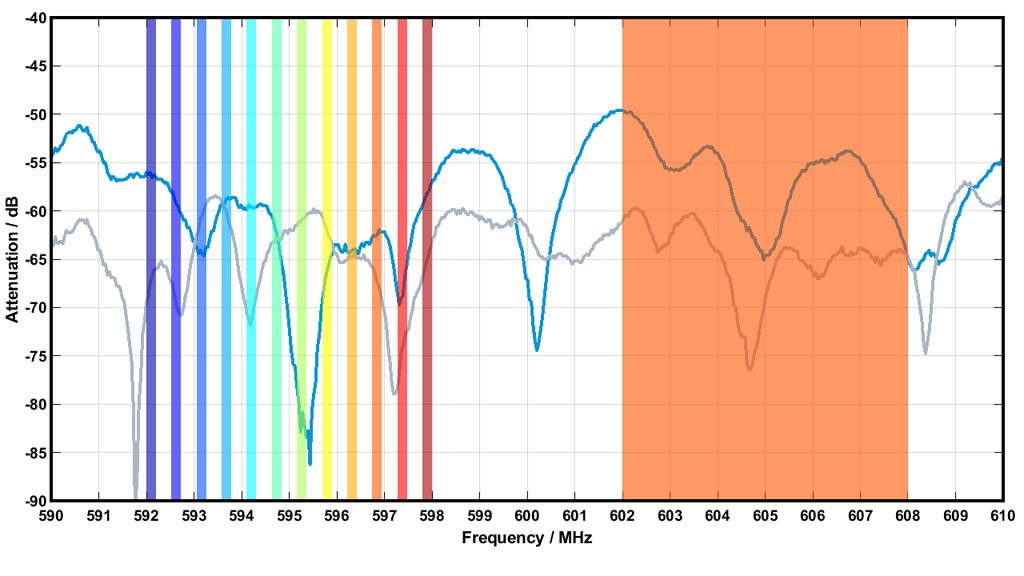News
24 Feb 2023
The Future of Wireless Audio

Subscribe to CX E-News
Wireless Multi-Channel Audio Systems will revolutionise large events
February 2023 – Alignment meetings with regulatory bodies, demonstrations to high-profile wireless users and decision-makers – is there a new type of wireless audio transmission on the horizon? While the rumour mill is leaking some details here and there, four Sennheiser experts reveal what this new technology is about. Dr Andreas Wilzeck (Head of Spectrum Policy and Standards), Martin Brandenburg (Project Manager), as well as Dr Sebastian Georgi and Jan Watermann – the two research and development engineers who are the inventors of what is called Wireless Multi-Channel Audio Systems (WMAS) – dive into the benefits of the technology and explain how it will change the wireless landscape.
Gentlemen, you are working on a new technology called WMAS, wireless multi-channel audio systems. What is this technology about? Who is it for?
Sebastian: “With this technology, we are re-thinking wireless transmission in multi-channel applications such as big live events, theatres, and broadcast studios – wherever many audio channels are up in the air. Sennheiser’s implementation of WMAS is essentially a bi-directional wireless broadband technology, which combines microphones, in-ears, and remote control in just one broadband RF channel.

When we started out with this development project, our original intention was to combat RF fading, the natural signal loss on stages. RF fading can cause signal dropouts, which is what makes every sound engineer’s job so difficult. By finding ways to better exploit the diversity offered by the broadband RF channel, we wanted to eliminate the risk of signal dropouts.
In addition, we aimed to simplify set-up for the user, acknowledging the fact that narrowband wireless systems require quite complex stage set-ups, especially in multi-channel applications.
Another goal was to make better use of the scarce frequency resources, an ever-increasing challenge that audio engineers are faced with.”
What is the difference of this broadband approach compared to today’s wireless microphone systems?
Jan: “Today’s wireless audio technology relies on narrowband RF solutions, with one transmitter sending signals to one receiver unit. And, unfortunately, the transmitter cannot notice whether ‘its’ receiver has been switched on or not, or whether it is out of range. In a figurative sense, you could say that every microphone, once configured, is fighting on its own.
Broadband wireless technology, on the other hand, is system-based, a cooperative approach, as it were. Many mobile devices are linked over the air with one rack-mount unit. Now, everything happens in a single broadband RF channel with a bandwidth of 6 or 8 MHz, the bandwidth of a TV channel. The audio engineer simply selects a carrier frequency for the broadband RF channel to be configured, and the system will coordinate itself, with the quality and range that the engineer chooses for the individual audio devices.

That sounds amazing, but does a solution that occupies a full TV channel – so 6 or 8 MHz of RF spectrum depending on where you are in the world – really save frequency resources?
Martin: “It does indeed. Just bear in mind that WMAS is designed for multi-channel audio applications that integrate wireless microphones, in-ear monitors, remote control, and other audio applications into one radio interface. This brings significant efficiencies in spectrum use – not just by technology, but also by enabling workflow improvements. These wins can be invested in flexibility and audio quality. For example, IEMs and microphones, which today are split between two RF ranges that are several MHz apart, can now be handled together in a single TV channel, which, in addition, makes frequency planning a breeze. But to be clear, narrowband, 200 kHz digital wireless microphones will continue to be used for applications where this integration is not required, or where only a few mics are used.

Secondly, our system will operate with a total of 50 mW of transmit power per RF broadband channel, which is the transmit power of a single microphone today. Within the capacity limit of the system, there will no longer be any scaling of the total transmit power by the number of devices used. Furthermore, this transmission power will be distributed over the entire RF broadband channel, so the spectral power density is lower by a factor of 30 (6 MHz) or 40 (8 MHz) compared to a single wireless microphone with a bandwidth of 200 kHz. This low spectral power density means that an RF channel can be reused more easily. This would, for example, be an asset in multi-studio broadcast production facilities or on the different stages of a spacious festival site.

Last but not least, our approach allows remote control of all equipment at all times, and also the allocation of resources to equipment as really needed at any given time. This makes it possible to save spectrum by employing a new workflow where the audio engineer can schedule resources on a timeline. Compared to today, where all devices would be actively transmitting at the same high quality all the time, this new workflow would mean a substantial gain in spectral efficiency at large events.
Overall, the Sennheiser solution will enable customers to significantly reduce their spectrum footprint while gaining unmatched integration, audio quality, low-latency transmission, control, and flexibility in their applications.”
Andreas: “It is worth noting that the number and complexity of large events and mega-events is continuously increasing, and the associated demand for radio spectrum is, too. This is not just statistics – securing enough spectrum for these big events is increasingly causing engineers and event organisers a headache, especially with outdoor events. The WMAS solution will certainly help.”

You mentioned that current narrow-band microphones have a stipulated maximum RF transmission bandwidth of 200 kHz, but your broadband microphone will depend on this limit being lifted. Have the regulatory bodies already agreed to do this – worldwide?
Andreas: “The relevant harmonised standard EN 300 422-1 for wireless microphones was amended in 2017 to take wireless multi-channel audio systems (WMAS) into account. This EN 300 422-1 standard is referenced more or less worldwide in the national regulations for the market access of wireless microphones.
We successfully initiated the necessary regulatory changes some years ago; they have already been implemented in many countries in EMEA and APAC. The process in the US is not yet complete, but we are confident that WMAS will soon be possible here, too.
The availability of products based on this breakthrough technology will naturally accelerate regulatory changes on a global scale, because after all, no country wants to get left behind.”
Are the frequency ranges WMAS will be operating in the same as those of today’s narrowband systems?
Andreas: “Yes, our WMAS solution will operate in co-existence in the standard UHF frequency ranges for wireless microphones – no changes to the transmission power limits are required. It was just the bandwidth limit that had to be removed or lifted to at least 6 MHz.”

Allow me to ask why you are using a manufacturer-specific transmission technique. Wouldn’t standard technologies – like, say, a 5G microphone with a SIM card – do the trick, too?
Martin: “By offering a bespoke solution, we can create tailor-made systems for our customers and their use cases. Live audio has very strict requirements on latency, operational reliability, multi-channel audio, and audio quality that standard technologies cannot – or do not want to – fulfil today or in the near future.”
Andreas: “In the end, our company will not be measured by the hype around a technology such as 5G, but by what we can deliver to our customers and what will work for their very specific applications and workflows.”
Sebastian: “In this context, it is worth mentioning that latencies advertised in 5G are measured differently than the audio stream latency requirements that we have to guarantee throughout an entire production.”
Could you once again summarise the advantages of this new WMAS approach?
Jan: “We have already mentioned the improved use of spectrum resources by the new workflows that become possible through WMAS, and the flexibility that the system offers for larger premises or festival grounds thanks to its lower spectral power density.
In addition, combined, bi-directional bodypacks including low-latency, true digital in-ear monitoring will be possible – bands and artists will just need one device instead of two. Mic transmission, in-ear monitoring, and permanent remote control will all happen via the same device in a single RF channel. Also, the sound engineer will be able to flexibly select the audio quality, latency, range, and resource occupation for every single audio transmission of the devices. Furthermore, all mobile devices will be perfectly synchronised, enabling wireless stereo and even 3D audio recording without any audio phase issues.”
Sebastian: “The backstage tech space will look very different, as WMAS will allow our customers to have the processing of 64 audio channels done by a single 19”/1U rack-mount unit! Gone will be the days of receiver cabinets – our customers will save backstage space, valuable truck space on tour and thus energy, too. Except for selecting a single RF channel, extensive frequency planning will not be required. If we want to come full circle, we can look at the RF fading challenge we set out to solve in the beginning: Instead of today’s typical spatial diversity with two antennas, WMAS will offer 30-fold diversity in a 6 MHz TV channel or 40-fold diversity in an 8 MHz TV channel – with a single antenna!”

One final question that many users will be interested in: Can today’s narrowband systems and the upcoming broadband systems co-exist?
Martin: “We have successfully tackled this challenge and will follow up with a series of publications that provide more in-depth knowledge about wireless multi-channel audio systems, including more information on co-existence. Stay tuned!”
To stay up to date, please visit the Sennheiser WMAS page (Sennheiser WMAS page) and subscribe to the dedicated WMAS newsletter.
About the Sennheiser brand
We live and breathe audio. We are driven by the passion to create audio solutions that make a difference. Building the future of audio and bringing remarkable sound experiences to our customers – this is what the Sennheiser brand has represented for more than 75 years. While professional audio solutions such as microphones, meeting solutions, streaming technologies and monitoring systems are part of the business of Sennheiser electronic GmbH & Co. KG, the business with consumer devices such as headphones, soundbars and speech-enhanced hearables is operated by Sonova Holding AG under the license of Sennheiser.
Subscribe
Published monthly since 1991, our famous AV industry magazine is free for download or pay for print. Subscribers also receive CX News, our free weekly email with the latest industry news and jobs.






